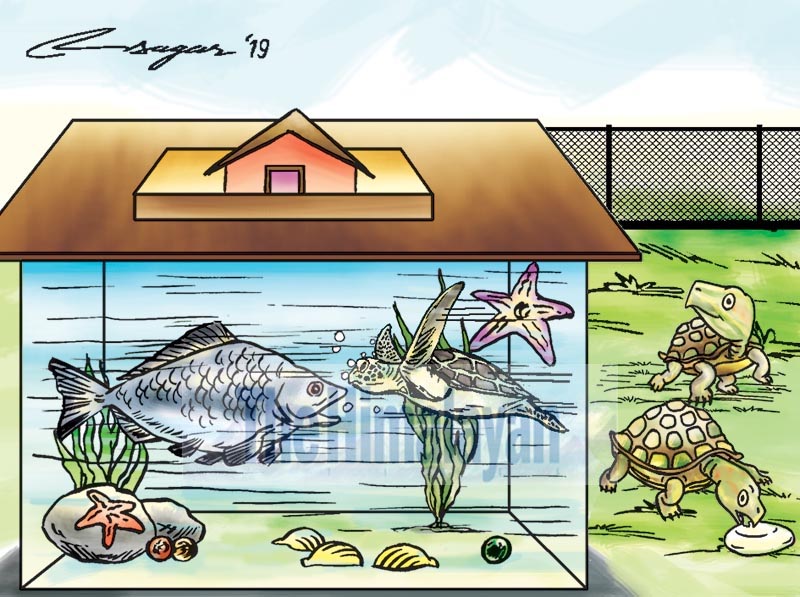Turtle conservation: Due attention awaited
Local exploitation, habitat fragmentation and its degradation along with the widely unregulated international trade have imperiled turtles and tortoises towards extinction. Those concerned by the situation should drive their attention towards the conservation of the species
Turtles and tortoises are a group of reptiles known for their special bony or cartilaginous shell developed from their ribs, which act as a shield. The Ganga River basin has been identified as an area with the highest diversity of turtles and tortoises, a region that Nepal is a part of. Thus, Nepal is rich in the diversity of these elusive reptiles, represented by seventeen sub-species belonging to sixteen species. Of these sixteen, four species found in Nepal, namely Kachuga dhongoka, Kachuga kachuga, Chitra indica and Indotestudo elongate are listed as critically endangered in the International Union for the Conservation of Nature (IUCN) red list, which make them in greater need of attention than even tigers.
But despite the immediate threat these turtles and tortoises face, they are yet to receive attention from the conservation sector. All the species of Nepal are listed either in appendix I or appendix II of the Convention on Endangered Species of Wild Fauna and Flora (CITES), a convention which aims to protect the species from trade-related threats. The listing of all species in the appendix of CITES means that turtles and tortoises in Nepal are, in fact, threatened by trade-related activities.
A study carried out in 2017 by students of Golden Gate International College regarding turtle trade within the Kathmandu Valley found that people in the capital are keeping elongata tortoise (Indotestudo elongata) and Indian flapshell turtle (Lissemys punctata andersoni) as pets. The same study identified places in Nepal, such as Nepalgunj, Butwal, Jhapa and Dang as the source of turtles and tortoises for the Kathmandu Valley. The number of people who are looking to keep turtles as pets is increasing. The growing demand for turtles is fulfilled mostly from the unregulated harvest carried out in Nepal and, more importantly, by the specimens imported illegally from other countries, mostly India.
But even more alarming than the trade of turtles as pets is the exploitation of these animals as a delicacy. The land tortoise, elongata tortoise (Indotestudo elongata), which is listed as critically endangered in the IUCN red list, and Tricaranita hill turtle (Melanochelys tricarinata), which is listed as vulnerable, are widely collected from community forests for this very purpose. This unregulated exploitation has resulted in the local extinction of the species in many parts of the country.
Some efforts have been made by the public sector for the conservation of turtles in Nepal. A Turtle Rescue and Conservation Centre (TRCC) has been established in Jhapa, where they are rescuing some of the turtles on a local scale, but the efforts of one turtle rescue centre will not suffice. As local exploitation is heavy, information and rescue centres in both the central and western regions of Nepal, with the motive of reducing the local exploitation and releasing the species to their original habitat, are required.
Besides local exploitation, habitat degradation, especially the decline in food availability due to overfishing and pollution of water resources are also plausible threats to the turtles and tortoises. But the exact relationship between human interference and the turtle and tortoise population is yet to be understood and quantified. Additionally, invasion by plants and certain turtle species could force native turtles towards local extinction.
Red Eared Sliders are considered invasive turtles all over the world. The species, though not native to Nepal, are in high demand in the pet trade market. The species can be observed at Taudaha Lake and other ponds of Nepal. There are also some reports of their breeding in some habitats. If unregulated, they have the potential to drive native species towards local extinction.
Although we have a general overview of the threats facing turtles, information about the turtles is limited. The total number of species is said to be 16, but the presence of some species is questioned. A comprehensive survey of turtles and tortoise carried out by Companions for Amphibians and Reptiles of Nepal (CARON) found no evidence of the presence of K. dhongoka, K. kachuga and Cyclemys oldhamii, while only broken shells of C. indica was observed.
In the same survey, the species Morenia petersi, the presence of which was recorded by Professor Karan Bahadur Shah in Gainda Tal, in 1995, was not found again in 2009. The survey team was further unable to locate the species elsewhere, indicating the local species had become extinct in Nepal.
Local exploitation, habitat fragmentation and its degradation along with the widely unregulated international trade have imperiled turtles and tortoises towards extinction. Those concerned by the situation should drive their attention, and the attention of the relevant authorities, towards the conservation of the species. Using a citizen science approach to understand the ecology and threats to the species, while concurrently devising a turtle and tortoise conservation action plan based on baseline information, we can take steps towards the conversation of these animals. Otherwise these beautiful creatures who have roamed the earth for 260 million years will disappear from this world forever.
Aryal is a researcher on tortoises






